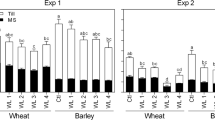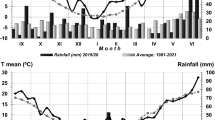Summary
Four accessions of Hordeum spontaneum and two of Hordeum vulgare were grown in pot conditions, and sampled at intervals before and after anthesis. Dry matter and nitrogen content of leaves, stems, and grains were measured. In general, H. spontaneum was characterized by higher vegetative nitrogen content, and greater allocation of dry matter resources to leaves rather than stems, compared to H. vulgare. The two small grain H. spontaneum accessions of ‘slender’ phenotypic type were much lower in leaf weight and somewhat lower in stem weight, than the two large grain ‘robust’ phenotypic types.
Post-anthesis observations showed that large grain H. vulgare (cv. Ruth) accumulated grain dry matter at a greater rate (rather than duration) than the other genotypes. Final dry matter harvest index was about 26% in H. vulgare, but only 14% in all four H. spontaneum accessions. Nitrogen harvest index was low in cv. Ruth (around 35%) and high in H. spontaneum and in the high protein cultivated line 859B (all around 65%).
Similar content being viewed by others
References
Ahokas, H., 1982. Variation of kernel protein and lysine in the wild progenitor of barley. Hereditas 96: 29–37.
Batten, G.D., 1986. The uptake and utilization of phosphorus and nitrogen by diploid, tetraploid and hexaploid wheats (Triticum spp.) Annals of Botany 58: 49–59.
Brunori, A., H., Axmann, A., Figueroa & A., Micke, 1980. Kinetics of nitrogen and dry matter accumulation in the developing seed of some varieties and mutant lines of Triticum aestivum. Z. Pflanzenzüchtg. 84: 201–218.
Brunori, A., A., Figueroa & A., Micke, 1984. Strategy of breeding for high protein content in Triticum aestivum. In: Cereal Grain Protein Improvement, International Atomic Energy Agency, Vienna, pp. 321–331.
Brunori, A., P., Mannino, G., Ancora & A., Bozzini, 1977. Protein accumulation, RNA and soluble amino nitrogen content in developing endosperm of two varieties of Triticum aestivum with high and low protein seed. Theor. Appl. Genet. 50: 73–77.
Corke, H., E. Nevo & D. Atsmon, 1988. Variation in vegetative parameters related to the nitrogen economy of wild barley, Hordeum spontaneum, in Israel. Euphytica 00: 000–000.
Dalling, M.J. 1985. The physiological basis of nitrogen redistribution during grain filling in cereals. In: J.E., Harper, L.E., Schrader & R.W., Howell (Eds). Exploitation of Physiological and Genetic Variability to Enhance Crop Productivity. American Society of Plant Physiologists, Rockville, Maryland, pp. 55–71.
Desai, R.M. & C.R., Bhatia, 1978. Nitrogen uptake and nitrogen harvest index in durum wheat cultivars varying in their grain protein concentration. Euphytica 27: 561–566.
Fischbeck, G., E., Schwarzbach, Z., Sobel & I., Wahl, 1976. Mildew resistance in Israeli populations of two rowed barley (Hordeum spontaneum). Z. Pflanzenzüchtg. 76: 163–166.
Frey, K.J., T.S. Cox, D.M. Rodgers & P. Bramel-Cox, 1984. Increasing cereal yields with genes from wild and weedy species. In: V.L. Chopra, B.C. Joshi, R.P. Sharma & H.C. Bansal (Eds), Genetics: new frontiers. XV Int. Congress of Genetics. Volume IV. Applied Genetics. Epping, United Kingdom; Bowker, pp. 51–68.
Harlan, J.R., 1971. On the origin of cultivated barley: a second look. In: Barley Genetics II, pp. 45–50. Proc. 2nd Int. Barley Genetics Symp. Pullman 1970.
Kramer, T., 1979. Environmental and genetic variation for protein content in winter wheat (Triticum aestivum L.). Euphytica 28: 209–218.
Kushnir, U. & G.M., Halloran, 1984. Plant nitrogen distribution in wild tetraploid (Triticum turgidum) and hexaploid wheat (Triticum aestivum). Euphytica 33: 641–649.
Moseman, J.G., E., Nevo & D., Zohary, 1983. Resistance of Hordeum spontaneum collected in Israel to infection with Erysiphe graminis hordei. Crop Sci. 23: 1115–1119.
Nevo, E., D., Atsmon & A., Beiles, 1985. Protein resources in wild barley, Hordeum spontaneum, in Israel: predictive method by ecology and allozyme markers. Pl. Syst. Evol. 150: 205–222.
Nevo, E., A., Beiles, Y., Gutterman, N., Storch & D., Kaplan, 1984. Genetic resources of wild cereals in Israel and vicinity. 2. Phenotypic variation within and between populations of wild barley, Hordeum spontaneum. Euphytica 33: 737–756.
Nevo, E., D., Zohary, A.H.D., Brown & M., Haber, 1979. Genetic diversity and environmental associations of wild barley, Hordeum spontaneum, in Israel. Evolution 33: 815–833.
Scholz, F., 1984. Some problems and implications in improving cereal grain protein by plant breeding. Kulturpflanze 32: S193-S203.
Treeful, L.M. & R.D., Wilcoxson, 1984. Resistance in Hordeum spontaneum to three races of Puccinia hordei. (Abstract) Phytopathology 74: 878.
Author information
Authors and Affiliations
Additional information
Incumbent of the Seagram Chair for Plant Science
Rights and permissions
About this article
Cite this article
Corke, H., Avivi, N. & Atsmon, D. Pre- and post-anthesis accumulation of dry matter and nitrogen in wild barley (Hordeum spontaneum) and in barley cultivars (H. vulgare) differing in final grain size and protein content. Euphytica 40, 127–134 (1989). https://doi.org/10.1007/BF00023307
Received:
Accepted:
Issue Date:
DOI: https://doi.org/10.1007/BF00023307




